Related Research Articles
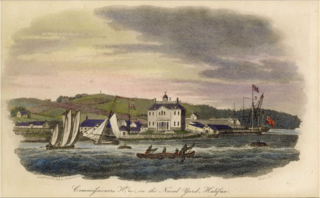
Royal Naval Dockyard, Halifax was a Royal Navy base in Halifax, Nova Scotia. Established in 1759, the Halifax Yard served as the headquarters for the Royal Navy's North American Station for sixty years, starting with the Seven Years' War. The Royal Navy continued to operate the station until it was closed in 1905. The station was sold to Canada in 1907 becoming His Majesty's Canadian Dockyard, a function it still serves today as part of CFB Halifax.

Colonel John Drinkwater Bethune was a British Army officer and military historian best known for his account of the Great Siege of Gibraltar that came out in 1785.
Arthur Batt Bingham (1784–1830) was an officer in the Royal Navy, rising to the rank of post captain. He is remembered chiefly for his command of HMS Little Belt, when the Little Belt affair occurred, just prior to the War of 1812.
Vice-Admiral Sir John Tremayne Rodd, KCB was an officer of the Royal Navy noted for his services during the Napoleonic Wars. Rodd served in a number of ships, including HMS San Josef under Admiral Sir Charles Cotton and HMS Indefatigable during the Battle of the Basque Roads.
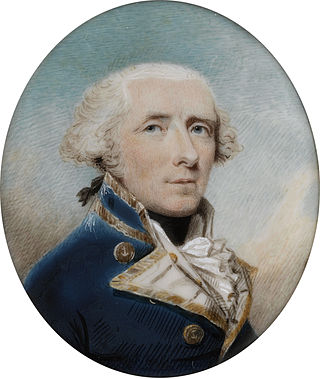
Admiral Skeffington Lutwidge was an officer of the Royal Navy who saw service during the American War of Independence, and the French Revolutionary and Napoleonic Wars. He had a particular connection with Horatio Nelson, who served under Lutwidge as a midshipman on an expedition to the Arctic in HMS Carcass in 1773, and again in 1801 while a captain, when Lutwidge was commander in chief in the Downs. Lutwidge served for a considerable period and in a number of ships, in American waters during the War of Independence. During this time he captured a number of American privateers, and was involved in operations on Lake Champlain. He reached flag rank soon after the start of the French Revolutionary Wars, and served mainly in Home waters as commander in chief of some of the stations on the south coast. He retired from active service with the rank of admiral, and died in 1814, shortly before the end of the Napoleonic Wars. He was the great-uncle of Lewis Carroll.
Vice Admiral Sir John Chambers White, KCB was a prominent British Royal Navy officer of the early nineteenth century, who participated in a number of engagements during the Napoleonic Wars. He achieved most of his fame in the late 1790s as the commander of HMS Sylph, a small brig operating in Northern European waters. White was able to capture a number of equivalent French, Spanish and Dutch vessels and on one occasion was instrumental in the destruction of a much larger French frigate by a British squadron. In 1798 he was with the squadron that discovered the French invasion attempt on Ireland and acted as a messenger in the campaign to destroy the invasion force that ended at the Battle of Tory Island. He was later flag captain for Sir John Borlase Warren and participated at the action of 13 March 1806 and the destruction of the Regulus in 1814. After the war, White largely retired, but retained several shore appointments and rose to the rank of vice-admiral.
Lieutenant-General Charles Griffiths was a British soldier, foster brother to Prince Frederick, Duke of York and Albany, Lieutenant-General and Captain of Yarmouth Castle, Isle of Wight.

Captain Sir Humphrey Fleming Senhouse was a British Royal Navy officer. He served in the Napoleonic Wars, War of 1812, and First Anglo-Chinese War. In China, he was the senior naval officer of the British fleet from 31 March 1841 until his death on board his flagship, HMS Blenheim, in Hong Kong from fever contracted during the capture of Canton.
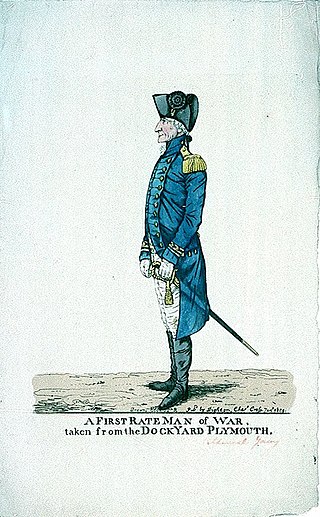
Admiral Sir William Young GCB was an officer of the Royal Navy who saw service during the American War of Independence, and the French Revolutionary and Napoleonic Wars. He should not be confused with his namesake and near contemporary Admiral William Young.
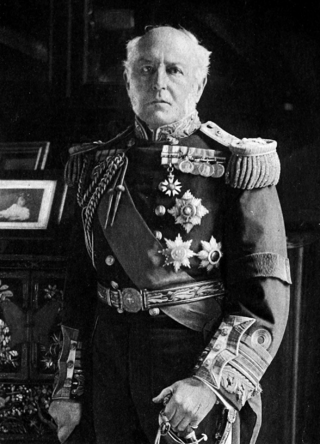
Admiral The Honourable Sir Edmund Robert Fremantle was a Royal Navy officer who served as Commander-in-Chief, Plymouth.
The High Sheriff of County Kilkenny was the British Crown's judicial representative in County Kilkenny, Ireland from the 16th century until 1922, when the office was abolished in the new Free State and replaced by the office of Kilkenny County Sheriff. The sheriff had judicial, electoral, ceremonial and administrative functions and executed High Court Writs. In 1908, an Order in Council made the Lord-Lieutenant the Sovereign's prime representative in a county and reduced the High Sheriff's precedence. However, the sheriff retained his responsibilities for the preservation of law and order in the county. The usual procedure for appointing the sheriff from 1660 onwards was that three persons were nominated at the beginning of each year from the county and the Lord Lieutenant then appointed his choice as High Sheriff for the remainder of the year. Often the other nominees were appointed as under-sheriffs. Sometimes a sheriff did not fulfil his entire term through death or other event and another sheriff was then appointed for the remainder of the year. The dates given hereunder are the dates of appointment. All addresses are in County Kilkenny unless stated otherwise.
The Sheriff of County Dublin was the Sovereign's judicial representative in County Dublin. Initially, an office for a lifetime, assigned by the Sovereign, the Sheriff became an annual appointment following the Provisions of Oxford in 1258. The first recorded Sheriff was Ralph Eure, appointed in that year. The next recorded Sheriff was Sir David de Offington, who was Sheriff in 1282. Besides his judicial importance, the sheriff had ceremonial and administrative functions and executed High Court Writs.
William Lechmere was an officer of the Royal Navy who served during the American War of Independence and the French Revolutionary and Napoleonic Wars.
Admiral John Child Purvis was a British Royal Navy officer of the late eighteenth and early nineteenth century best known for his service with the British Mediterranean Fleet during the French Revolutionary and Napoleonic Wars. Coming from a naval family, Purvis first saw action in small ships during the American Revolutionary War, later commanding a ship of the line with the Mediterranean Fleet during 1793-1796. During this period he fought in several significant battles against the French. He then served with the Channel Fleet operating at the blockade of Brest and in the Napoleonic Wars was promoted and tasked with maintaining the blockade of Cadiz. After the outbreak of the Peninsular War, Purvis was active in preventing the French capture of Cadiz and at one stage destroyed the city's seaward defences. He retired post-war to his home in Hampshire.

Captain Paul Henry Ourry (1719–1783) was a Royal Navy officer and British politician who sat in the House of Commons from 1763 to 1775.
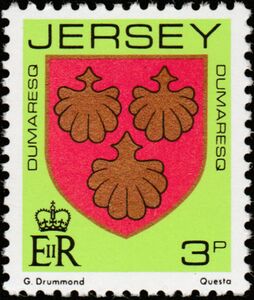
The Dumaresq family was a patrician family in the Channel Islands with a particularly strong presence in Jersey. The family would hold many offices and positions throughout the history of Jersey from the 13th century.

Admiral Thomas Dumaresq was an officer in the British Royal Navy that rose to the rank of Admiral. Dumaresq was notable for his role as Captain of HMS Repulse in the Battle of the Saintes during the American Revolutionary War.

Elias Dumaresq, 3rd Seigneur of Augrès was born to Abraham Dumaresq, 2nd Seigneur of Augrès and Susan de Carteret daughter of Philippe de Carteret I, 2nd Seigneur of Sark and his wife Racheal Paulet. He was a Royalist and a Jurat of the Royal Court.
Nicholas Diddams (c.1760–1823) was a Master Shipwright mainly building for the Royal Navy.
John Drummond, 12th of Lennoch, 5th of Megginch, was a Scottish politician who served as MP for Shaftesbury.
References
- ↑ Burke, Bernard (1871). A Genealogical and Heraldic History of the Landed Gentry of Great Britain & Ireland. Harrison.
- ↑ "Royal Naval uniform: pattern 1843 - National Maritime Museum". collections.rmg.co.uk. Retrieved 8 April 2021.
- ↑ "George Ourry Lempriere". threedecks.org. Retrieved 8 April 2021.
- ↑ "Collections - National Maritime Museum". collections.rmg.co.uk. Retrieved 8 April 2021.
- ↑ "British Fifth Rate frigate 'Trent' (1796)". threedecks.org. Retrieved 8 April 2021.
- ↑ Payne, J. Bertrand (1862). A Monograph of the House of Lempriere. London.
{{cite book}}: CS1 maint: location missing publisher (link) - ↑ O'Byrne, William R. (1849). . A Naval Biographical Dictionary . Vol. 13.2. London: John Murray. p. 649.
- ↑ Burke, Bernard (1871). A Genealogical and Heraldic History of the Landed Gentry of Great Britain & Ireland. Harrison.